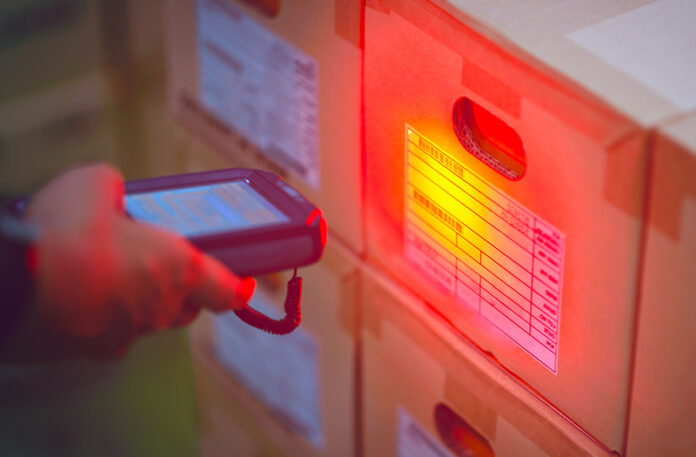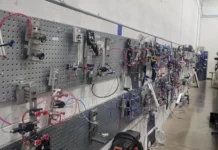by Al Wilson
RFID (Radio Frequency Identification) is a big buzzword in today’s U.S. manufacturing/distribution supply chain. RFID is an accurate automated method used for product tracking and identification. The information contained in a RFID chip (or tag) can be used to identify or locate specific tangible products within its allowed proximity.
How Does It Work?
RFID consists of a programmable chip that attaches to a product in some form. The chip can be attached to a tangible product by way of label or tag, or it can be capsulated. The chip stores data and uses radio waves to transmit data information in a manner that is very similar to cell phone towers.
Two types of tags exist: active and passive. Active tags use an internal power source (battery) to continually send radio waves that reach out for a connection. With Passive tags, the energy is transferred from the reader to the RFID chip to activate the chip without the use of a battery.
RFID tags are attached to an antenna on an inlay, which in turn, is attached to the blank label on the adhesive side. The chip is given a number assigned from each company’s software – a number unique from any other. The printer then encodes the chip as the label comes out of the printer. Currently, this process of programming the chip has achieved an extremely high success rate.
RFID printers now have advanced to print-and-apply automation systems on assembly lines, which are used for high volume production or in instances where automation without human intervention is desired. The “read rate” for each product traveling down a conveyor line or on a skid is 100 tags per second, moving at a rate of 10 mph.
Additionally, an RFID programmed label now exists that can be imprinted with information to be read by humans. For example, the printed label is put on a case, which then is placed on a skid; the cases will then be put on a skid and one skid label will be applied to the skid. Now every case on the skid is related to the one skid label and thus, a relationship has been established.
Let’s break this relationship down to something we all understand very well – our own social security number – a number unique to each and every one of us. Recently, the population of the United States was reported at three hundred million – that’s three hundred million unique social security numbers. In our example, RFID works the same way, with case labels being related to the skid label. RFID is a series of relationships by unique numbers.
Essentially, this is how RFID, as we know it, works today. While many people are under the concept that RFID is programming the micro chip itself with a lot of information, it’s really just a series of relationships associated with one unique number.
Why RFID?
In today’s fast paced environment, manufacturing and supply chains are always looking for bigger, better, and faster ways to stay competitive. RFID automated data capturing devices can help give companies an edge in inventory control, shipping, receiving, and tracking. The print and RFID coding methods are extremely fast for production lines, especially with RFID automated print-and-apply systems.
RFID will not replace the printing of barcodes on on-demand printing systems, but the learning curve for implementing data collection technology is already in place. Manufacturers have been bar coding for years now and understand the process quite well. RFID is already used in a number of different applications today, as mandated by Wal-Mart and the Department of Defense. The mandate is at a case and skid level for most suppliers. These mandates are just the beginning. Other organizations such as Lowes, Home Depot, Target, and automotive manufacturers soon will follow.
As a result of the implementation of RFID, the industry will begin to see several changes. For instance, retailers continually lose a percentage of sales due to out of stock items on the shelf; but with RFID, the day will come when the shelves automatically will communicate to the back of the store for someone to restock the product. In addition, purchase orders will be generated to the manufacturers directly from the store, eliminating the need for distribution centers. This will become the trend for retail and, most likely, will move into other forms of manufacturing and distribution as well.
Suppliers will benefit, too. Supply chain centers will not have to hand scan product, since readers will be placed in the plants to pick up radio waves; inventory control will be at a simple key stroke; and suppliers will have the ability to know where their product is at all times.
Have you ever had a customer not pay you for the product you shipped to them? Think about how much time and money is wasted in tracking that shipped product. Now RFID can help!
RFID technology allows manufacturers and distributors to track your product, lift truck, and even the operator of the lift truck. Readers can be installed at the dock door, along with cameras to validate that the products were shipped. Manufacturers now can prove the shipping discrepancy in their favor – providing proof that John Doe put the product on the truck at this time, this day, and – as further evidence – they can provide a picture of this happening. An advanced ship notice also can be sent as a shipment leaves the dock. This is just one way to make RFID work in your favor for a return on investment (ROI).
If you remember, bar coding started in this same way. Wal-Mart, the Department of Defense, and automotive manufactures wanted all of their suppliers to bar code products to meet their requirements so they could keep track of specific items. The suppliers turned the bar coding around and made the system work for themselves.
RFID will work with the same approach, only with much faster implementation due to the fact that manufacturers and suppliers already bar code products.
RFID and Manufacturing
We’ve talked about retailers. Now it’s time to talk about why manufacturing companies will be using RFID in the very near future. As mentioned earlier, RFID will provide a better handle on the inventory of finished goods, as well as on raw materials.
Imagine having an RFID-ready warehouse and trying to track a product that is being moved! You could know the lift truck driver, which lift truck he was driving, which way he was going, what time he was moving the product, what product, and where that driver put the product.
Have you ever had problems finding product in a warehouse? Let’s say, for instance, the warehouse is not RFID-ready. Currently, you probably send a driver into the warehouse and the driver starts moving skids around to find the product. Sound familiar? But, let’s imagine instead that you are tagging the skid with a RFID tag for your warehouse. Today, you can track the RFID tag with advanced scanning devices that will pick up radio waves. Now the people going into the warehouse will have the ability to find a particular product in a timely fashion.
Implementing RFID with Plastics Manufacturing
In the business of plastic manufacturing, you may need to mold chips into your parts for traceability. Todays plastics industry is already molding in overlays and membrane switches very successfully.
Molding the chips into plastic is a process that will have to be worked out in your environment and with your particular application. So how does a molder buy a system to get started? One question that comes up frequently is, “Can I use my existing equipment?” The answer is, “No, you will have to purchase a RFID printer.” The important difference between what you have today and what you’ll need is that the RFID coder is in the printer. The buying process for this technology will require research. My number one suggestion is that you do not try to short-cut the buying process. I realize that everyone has to cut costs to contend in this competitive marketplace. However, as you enter into RFID technology, you need someone to be accountable, and that would be the person or company that you choose to implement the project.
I have already seen this happen. The buyer bought labels from one supplier, printers from another, and software from yet another – and nothing worked. The company had nowhere to turn to start fixing problems. My recommendation would be to get the system running as a first step and figure out how to use it. After this process takes place, move into finding a good RFID label/ribbon supplier that will be responsible for its product.
Start small and work your way up. Evaluate your problem areas and try to find an RFID solution – or determine if RFID even is the solution. It will take time to implement RFID technology – it is very powerful and you will not be able to “flip a switch” and watch it all come together. It will be a process for anyone getting into it. However, the time is now, because this technology will revolutionize supply chain management, today and well into the future.
Al Wilson is president and CEO at Quest Service Labs. Quest Service Labs is a leading hardware, software, integrator, sales, and service organization. The company is RFID Certified by the following: LEXMARK, CTM, SATO, Zebra, Datamax, Symbol, and PSC. For more information, contact Al Wilson at (330) 405-0316 or visit www.questservicelabs.com.





